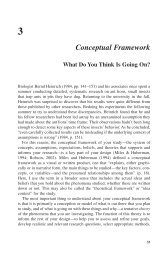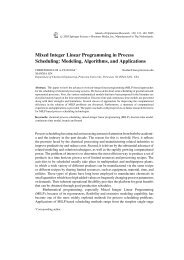Qualitative Research Basics: A Guide for Engineering Educators
Qualitative Research Basics: A Guide for Engineering Educators
Qualitative Research Basics: A Guide for Engineering Educators
You also want an ePaper? Increase the reach of your titles
YUMPU automatically turns print PDFs into web optimized ePapers that Google loves.
esearcher’s findings are plausible; that is, would reasonable people believe that they are<br />
accurate descriptions? In order to achieve credible findings, they advocate the following:<br />
• Use prolonged engagement and persistent observation. Stay in the field long<br />
enough and look at as many cases as needed to thoroughly know the phenomenon<br />
of interest.<br />
• Triangulate (compare results of) different methods, sources, and theories. Capture<br />
multiple points of view, use different approaches, and entertain different<br />
theoretical perspectives to look <strong>for</strong> patterns that persist across all of these.<br />
• Triangulate researcher perspective using peer debriefing. Confer with colleagues<br />
about methods and data interpretation to ascertain whether approaches are<br />
reasonable and appropriate.<br />
• Triangulate with participants using member checks. Interact with research<br />
participants or those who are contributing data to ask whether your data recording<br />
and interpretations are accurate from their points of view.<br />
• Collect referential adequacy materials. Seek out descriptions, quotations,<br />
documents, or products that provide the support <strong>for</strong> your interpretations.<br />
• Use structural corroboration. Make sure that your arguments hang together and<br />
make sense, that they are logical and describe the data well.<br />
Reliability is the concern with consistency of the methods and findings. Its parallel in<br />
Lincoln and Guba’s (1985) scheme is “dependability.” They advocate that researchers<br />
use “overlap methods,” by which they mean triangulation of method as described above,<br />
and “stepwise replication,” the systematic checking of research processed during the<br />
study. They also suggest that researchers leave an “audit trail,” describing their<br />
approaches carefully and detailing what inferences they made in drawing their<br />
conclusions. An external auditor should be able to look at the evidence and make a<br />
judgment about the dependability of the research.<br />
Objectivity is another of the traditional criteria that requires reconceptualization in a<br />
multiple-truths paradigm. The concern is with researcher bias and there are several<br />
approaches to this issue. The most common is to have colleagues of the researcher, either<br />
through the triangulation or audit approaches described above, examine the work <strong>for</strong> bias.<br />
A more fundamental approach is to assert that all research is conducted from the position<br />
of the researcher and so is inherently “subjective.” More conservative scholars suggest<br />
that by describing their positionality thoroughly, researchers can control their bias<br />
through the use of devices such as reflexive journals, surfacing to conscious awareness<br />
their emotional reactions and taken <strong>for</strong> granted assumptions. They also recommend that<br />
the researcher alert the user of the research to the point of view through which the<br />
research was conducted by describing this fully in the research report. Less conservative<br />
scholars argue that one’s positionality is a source of strength and is an essential part of<br />
the research. They agree that this perspective should be described as openly as possible<br />
<strong>for</strong> the user of the research but not from the point of view of trying to control one’s<br />
subjectivity, but to use one’s life experience and judgments as an important research tool<br />
and to reveal this perspective as well. In critical approaches, an identified lens, such as<br />
Critical Race Theory, Feminist Theory, or Marxism, is an essential part of the method,<br />
which does not pursue an unbiased view, but rather an identified one. The avowed aim of<br />
38
















